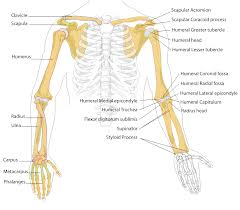
The primary protein that makes up bone, collagen, has a higher tensile strength than steel, but it has a flexibility that allows it to absorb tremendous pressure. A mineral, calcium phosphate, helps create hard bone. Because of this, bones are both strong and flexible. This is important for the large bones in the arm as it is human instinct to throw our arms in front of us during moments of panic, whether it be a car accident or simply bumping into a wall.
The large bones of the arm include:
The ends of the radius and ulna join bones at the hand to form the wrist, which is formally known as the carpus. Together with the bones in the palm of the hand, these bones form three rows. The bones of the wrist are:
Aidan Raftery
Sports Therapist
The large bones of the arm include:
- Humerus: This bone runs down from the shoulder socket and joins the radius and ulna at the elbow.
- Radius: A forearm bone, it runs from the elbow to the thumb side of the wrist.
- Ulna: This forearm bone runs from the elbow to the “pinkie” side of the wrist.
The ends of the radius and ulna join bones at the hand to form the wrist, which is formally known as the carpus. Together with the bones in the palm of the hand, these bones form three rows. The bones of the wrist are:
- Scaphoid Lunate Triquetrum Trapezium Capitate Hamate
- Proximal phalanges: The largest of the three, these extend directly from the palm. These are where rings rest.
- Intermediate phalanges: These are situated between the two joints of the fingers.
- Distal phalanges: These are your fingertips.
Aidan Raftery
Sports Therapist
 RSS Feed
RSS Feed
